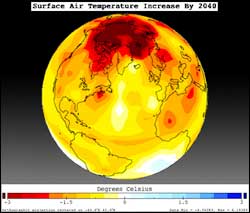

College and high school students can now see how Earth’s climate is changing without leaving their computers.
NASA and other organizations use NASA’s global climate computer model (GCM) to see how Earth’s climate is changing. A GCM calculates many things, such as how much sunlight is reflected and absorbed by Earth’s atmosphere, the temperature of the air and oceans, the distribution of clouds, rainfall, and snow, and what may happen to the polar ice caps in the future.
Scientists run the GCM on supercomputers to simulate climate changes of the past and future, and an educational version is now be available to educators and students at universities and high schools, where desktop PCs are the norm.
The Educational Global Climate Model (EdGCM), available for both Windows and Mac platforms, was unveiled at the Annual meeting of the American Meteorological Society, at the San Diego Convention Center, San Diego, Calif. on Monday, January 10, 2005.
EdGCM incorporates a 3-D climate computer model developed at NASA’s Goddard Institute for Space Studies, New York, includes complex computer programs in a way that will be familiar to most PC users. Though the climate model runs on a desktop computer, it still allows teachers and students to conduct experiments identical to those that scientists are running. Additionally, EdGCM links the climate model to both a database and scientific visualization tools, making it simpler to create and organize data and images.
“The real goal of EdGCM is to allow teachers and students to learn more about climate science by participating in the full scientific process, including experiment design, running model simulations, analyzing data, and reporting on results via the world wide web,” said Mark Chandler, lead researcher for the EdGCM project from Columbia University in New York City.
An “EdGCM Cooperative” is also being designed to encourage communication between students at different schools and between schools and research institutions. This cooperative will help students become familiar with the role that teamwork plays in scientific research today.
Educational materials associated with the EdGCM project are also under development. A curriculum module on carbon dioxide (CO2) and global warming will walk students through a complete scientific project involving GCMs and analyzing a changing climate. Students will also be able to re-create ancient climates from the times of the dinosaurs or the water cycles of future climates.
Professors at three N.Y. area universities are already using EdGCM. Professors and students at Columbia University, City University of New York, and New York University, can now conduct research projects using the NASA/GISS GCM. At least two high schools in Madison, Wis. are also testing EdGCM this semester in Earth Science courses, and several other schools may begin using the software next year.
“EdGCM is not just for looking at climate on the Earth,” Chandler said. We’re keeping an eye on being able to use it to eventually simulate the atmospheres of other planets, too.”
For more information on this story, please visit on the Internet:
http://www.nasa.gov/vision/earth/everydaylife/climate_class.html
For more information on this project please visit the EdGCM web site at:
http://www.edgcm.org
To download EdGCM software from the Internet, please visit:
http://www.edgcm.org/EdGCMCooperative/Downloads.php














